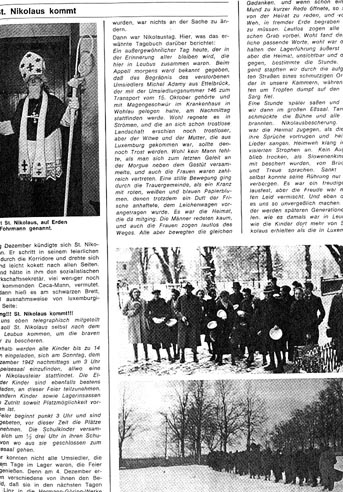
From the book ALS LUXEMBOURG ENTVÖLKERT WERDEN SOLLTE: GESCHICHTE UND GESCHICHTEN DER UMSIEDLUNG, GLEITWORT VON PIERRE GREGOIRE, MINISTER FÜR KUNST UND WISSENSCHAFT, VERLAG BOURG-BOURGER, LUXEMBOURG, 1969. [WHEN LUXEMBOURG WAS TO BE DEPOPULATED: HISTORY AND STORIES OF THE RESETTLEMENT, INTRODUCTION BY PIERRE GREGOIRE, MINISTER FOR ART AND SCIENCE, BOURG-BOURGER PUBLISHING HOUSE, LUXEMBOURG, 1969]
AUTHOR: EVY FRIEDRICH. Reprinted by Imprimerie St. Paul, 1969. "Luxembourger Wort" archive reference: A675.
Please note: The author's name is spelled "Friedrich", without "s". I misspelled it for many years, for which I apologize.
---
According to the prosecution at Nuremberg, "resettlement" was a fiendishly clever euphemism for "extermination". In reality, it meant simply what it said: resettlement or relocation.
The people in these photographs -- exactly like the Japanese in California -- were "resettled" during the war to remote areas of Poland, usually castles or large landed estates, because they were considered politically unreliable during the wartime occupation of Luxembourg (a standard measure which is perfectly legal under international law). Unlike the Japanese, however, holed up in freezing, sweltering tar-paper shacks in the Mojave desert, these people appear to have lived a rather idyllic life.
The book shows inmates dressed up as "Father Christmas" (i.e., Santa Claus)
enjoying Christmas parties with Christmas trees and complete decorations
(p. 111, above),
wearing funny hats at New Year's parties
(p. 88, above),
playing cards
(p. 48, above),
playing hopscotch and children's games
(p. 57, above),
receiving proper dental care
(p. 49),
getting married with full bridal gown, tuxedo, etc.
(p. 89, above), etc. etc.
(Note joyful fishing party, German officer respectfully attending the funeral of an inmate, etc. etc.)
(p. 107, above).
(This man was sentenced to 24 hours "strict arrest" for repeated absence from work. Under Stalin, he would have been shot.)
These people are enjoying an "intimate Christmas celebration with roommates"
(p. 29).
There is hardly a single photograph in which these people are not all smiling; see, in particular,
(p. 75, note football team).
Many of these "Umsiedlungslager" locations were extremely beautiful (particularly, Leubus and Schloß Boberstein); the latter was used as a holiday resort by the Poles after the war.
See also "MISCELLANEOUS UMSIEDLUNGSLAGER PHOTOS". It is respectfully submitted that these photographs are totally inconsistent with the myth of Nazi barbarity and cruelty.
CARLOS W. PORTER
AUGUST 10, 2004
Return to CONTENTS PAGE